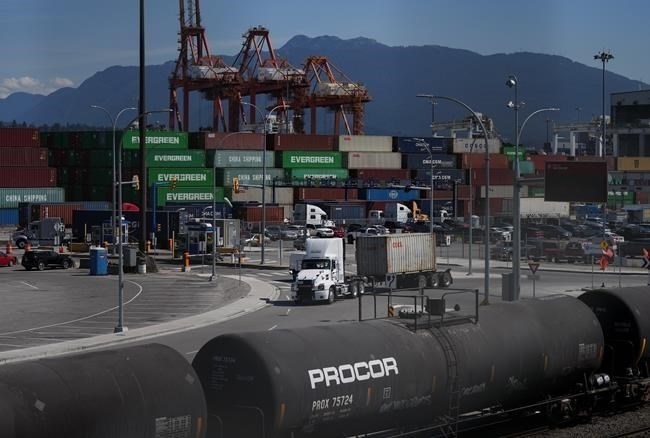
The Vancouver Fraser Port Authority says a record cargo volume rolled through its terminals last year, despite a sputtering global economy and a big drop in container shipments. Transport trucks carry cargo containers at port in Vancouver, on Friday, July 14, 2023.
Image Credit: THE CANADIAN PRESS/Darryl Dyck
March 24, 2024 - 9:00 PM
Attacks on cargo vessels in the Red Sea could drive more shippers toward the Port of Vancouver after a year of record-high volumes, its CEO said.
"We know that the Red Sea impacts have caused significant rerouting of cargo for vessel operators to all markets," Peter Xotta, the head of the Vancouver Fraser Port Authority, said in an interview Friday.
"I expect that that could result in an increase in the short term for cargo into the Port of Vancouver," he said. "We have seen a bump in volume in the early part of 2024. Some of that could be partly related to those events."
Whether the trend continues depends on events closer to the Suez Canal, which container ships have largely avoided for months due to the ongoing conflict in the region.
Since December, maritime attacks by Iran-backed Houthi militants have pushed shippers to steer clear of the Red Sea and reroute around Africa, adding weeks to the journey.
On March 6, fighters struck the bulk carrier True Confidence, killing three civilians, the first deaths since the militants began to target ships linked to Israel, the U.S. or U.K.
A smattering of cargo vessels have opted to head east across the Pacific Ocean to North America from parts of Asia rather than make the prolonged westward voyage around the Cape of Good Hope.
"Any of these things that create greater volatility in the supply chain ultimately impact its performance and its cost," Xotta said. "So greater stability is a good thing."
Last year, an unprecedented 150.4 million tonnes of bulk, breakbulk and container goods traversed the docks at Canada's largest port, the Vancouver Fraser Port Authority said.
The surge marked a six per cent increase from 2022, despite a sputtering global economy and a big drop in container shipments.
Bulk exports — wheat, canola and petroleum, especially — drove the increase, as did container exports and auto imports.
However, overstocked retail inventories and cooling demand dragged down container imports — and container shipments overall — the port authority said.
“It was a mixed year at the Port of Vancouver, with growth in some sectors and softening in others,” the federal agency said in a release.
"With the pandemic early on, we saw very strong consumer purchasing driving container volumes," Xotta said in the interview.
He also noted the subsequent decline in spending on consumer items amid a higher cost of living and expenditures diverted increasingly toward services rather than products.
"One could foreshadow that through the course of 2024 and certainly early 2025 we'll start to see recovery," he said. "At least that's our hope."
A big drop in household goods — the category accounts for nearly a third of inbound container items, from towels to televisions — drove a 12 per cent decrease in container shipments overall at the port.
Some 79 per cent of household products came from China, with Vietnam and South Korea as distant runners-up. Fewer imported construction materials and industrial and auto parts also fuelled the fall in container figures.
The ramp-up in container exports — especially boxes loaded with wood pulp and specialty crops, such as lentils bound for India — helped offset the inbound slump.
An economic slowdown, a 13-day strike by B.C. dockworkers in July and ongoing disruptions along the Red Sea and Panama Canal trade routes all posed challenges to smooth operations at the port, Xotta said.
Its 12 per cent boost in overall exports to 142 countries in spite of those hurdles showcased the value of a diverse range of shipment types and national partners, he added.
Grain and crude oil — China and the U.S., respectively, received the most — drove the spike in bulk exports on the heels of a bumper crop and a record surge in oil output from Alberta. Fewer exports of forest products and fertilizer tamped down the figures.
Meanwhile, the number of vehicles that entered Canada via the port rose 36 per cent to more than 454,000, as manufacturers smoothed out supply chains.
But for many shippers, the year launched on stormy seas.
A drought in Central America piled on more problems amid the Red Sea crisis. The dry spell has sapped the Panama Canal of water, which is used to raise and lower ships at a dozen locks, prompting officials to cut the number of boats they let through the waterway.
"I anticipate that folks will be looking at the potential through Canadian supply chains as a result," Xotta said.
However, routes between East Asia and the West Coast are generally less affected. While shipping rates on loads to the western United States from East Asia have tripled over the past year, rates on cargo headed the other direction have dropped 28 per cent, according to freight analytics firm Xeneta.
On Asia-Europe routes, rates have soared for cargo boats coming and going.
This report by The Canadian Press was first published March 22, 2024.
News from © The Canadian Press, 2024